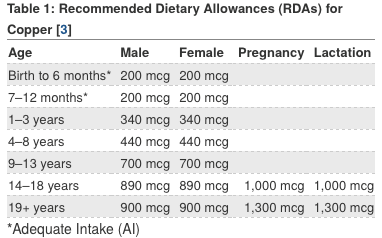Blog
Copper in Your Diet – Why You Need It and Where to Find It
By Lilian Grey a recent ASU Nutrition Student
Copper is an essential nutrient.
Essential nutrients are nutrients that your body can’t make on its own – you must get the nutrient from outside sources (think foods or supplements), and your body must have the nutrient to function.
Copper acts as a cofactor – cofactors are helpers that are required to unlock (catalyze) biological functions that are happening all throughout your body.
Copper has many jobs and starts working from the very start – as in during fetal development. Copper helps link together all the connections that make up your brain and nervous system – and helps create (plus maintains) connective tissue, cardiovascular tissue, and bones.
Along with shaping our entire body, copper is also responsible for helping fuel it – because it is a cofactor for cellular energy (ATP) production. ATP is the energy molecule that drives the function of every cell within your body.
And coppers influence doesn’t stop there – it also helps protect your body. Copper is essential to keeping your immune cell count high, which enables you to fight off invading bugs.
Copper stays busy working throughout our whole body – building, maintaining, connecting, and protecting.
Once we see the essential role copper plays in our body, it becomes clear as to why we have to ensure our diet contains enough of it.

(Office of Dietary Supplements – Copper. NIH Office of Dietary Supplements. https://ods.od.nih.gov/factsheets/Copper-HealthProfessional/)
Make sure you’re getting enough copper by eating foods rich in copper such as
- Nuts and seeds
- Whole grain products
- Shellfish

Looking for more articles to help boost your healthy living? Check out our Fill Your Plate Blog. Looking for some recipes that the whole family will enjoy? Check out the recipe section on our website.
References
Ravven W. Copper: A new player in health and disease. Research UC Berkeley. https://vcresearch.berkeley.edu/news/profile/chris_chang. Published May 17, 2016.
Uriu-Adams JY, Scherr RE, Lanoue L, Keen CL. Influence of copper on early development: prenatal and postnatal considerations. BioFactors (Oxford, England). https://www.ncbi.nlm.nih.gov/pubmed/20232410. Published 2010.
Xu W, Barrientos T, Andrews NC. Iron and copper in mitochondrial diseases. Cell metabolism. https://www.ncbi.nlm.nih.gov/pmc/articles/PMC3594794/. Published March 5, 2013.
Percival SS. Copper and immunity. The American journal of clinical nutrition. https://www.ncbi.nlm.nih.gov/pubmed/9587153. Published May 1998.
Office of Dietary Supplements – Copper. NIH Office of Dietary Supplements. https://ods.od.nih.gov/factsheets/Copper-HealthProfessional/.
















